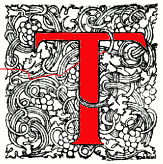In transcribing the following paragraphs from the Internet Archive online version of The Imperial Gazetteer’s entry on Egypt I have divided the long entry into separate documents, expanded abbreviations for easier reading, and added paragraphing and links to material in the Victorian Web. Unless otherwise noted, charts and illustrations come from the original Gazetteer. — George P. Landow

he monuments here briefly indicated, furnish, in truth, a very ample literary store. The inscriptions, when long, can rarely be read completely; for though the Coptic affords a key to the structure of the ancient language, it sup plies but an imperfect vocabulary. These difficulties may, however, be overcome by persevering study, and the monu ments of Egypt will probably hereafter enable us to retrace with certainty the earliest dates of civilization. Hieroglyphic writing continued in use down at least to the third century of the Christian era. Besides the hieroglyphic or monumental graven characters, the Egyptians used also the hieratic, which were, in fact, only the former reduced and adapted to the pen. The demotic or popular writing was probably of later date, derived from the hieratic, but with a more simple and cursive style. In some cases, monuments were inscribed in two or more of these styles, and in later ages, the Greek version of the inscription also was occasionally added; to this circumstance chiefly, we owe the discovery of the hieroglyphic alphabet.
Among the trophies brought by the British army from Egypt, was the Rosetta stone, now in the British Museum. This is a large black slab, covered with inscriptions in three different characters. The last of these is Greek, and informs us, that in the ninth year of Ptolemy Epiphanes (196 B.C.), the priests of Egypt, convened for the purpose, decreed certain honours to that King, and ordered that their decree should be engraved on hard stone, in Sacred (hieroglyphic), demotic, and Greek characters. The certainty that the hieroglyphic incription here contained the same matter as the Greek, induced Dr. T. Young, in 1813, to examine it attentively, and he soon detected the often-repeated names of Ptolemy and Cleopatra.
The first steps being made successfully, the progress that ensued in this new line of investigation was astonishingly rapid, insomuch that Champollion left behind him at his death, in 1830, a complete Egyptian grammar and dictionary of hieroglyphics. The full consequences of this remakable discovery are not yet developed. Patient philological research and the comparison of inscriptions will, doubtless, eventually disperse the obscurity which now hangs over the Egyptian language. But at present we have a much better knowledge of the monuments and history of ancient Egypt, than the Greeks or Romans, and we can ourselves read critically those records of the victories of Tothmes III in the temple of Karnak, which, as Tacitus relates, were interpreted by the priests for Germanicus. [2.912-13]
Bibliography
Blackie, Walker Graham. The Imperial Gazetteer: A General Dictionary of Geography, Physical, Political, Statistical and Descriptive. 4 vols. London: Blackie & Son, 1856. Internet Archive. Inline version of a copy in the University of California Library. Web. 31 July 2020.
Last modified 1 August 2020